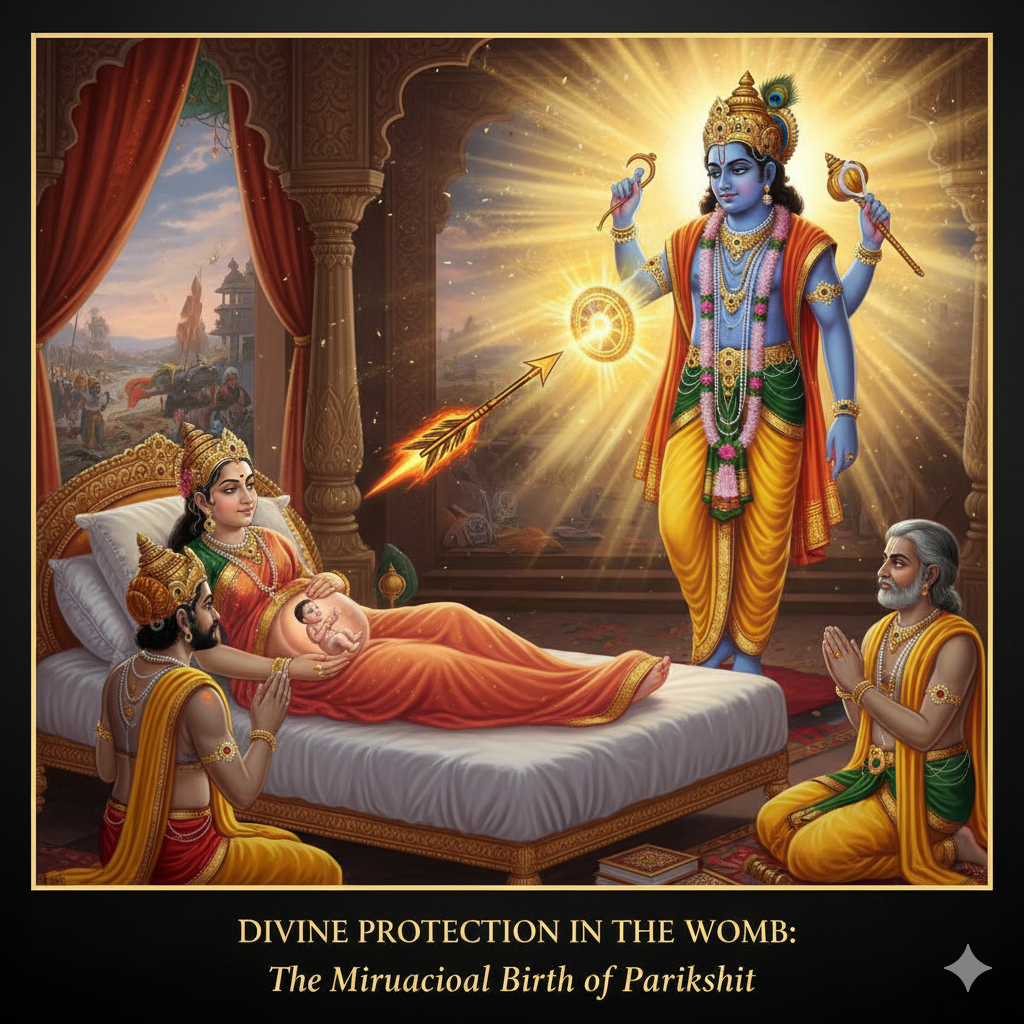The birth of Parikshit represents one of the most extraordinary episodes in the Mahabharata, showcasing divine intervention at its most crucial moment. This remarkable event not only ensured the continuation of the Pandava lineage but also set the stage for the narration of the Srimad Bhagavatam, making Parikshit’s birth pivotal to both historical and spiritual literature.
The Last Hope of the Pandavas
Parikshit, the son of Abhimanyu and Uttara, was born as the sole surviving heir of the Pandava dynasty. His father Abhimanyu, Arjuna’s brave son, had died heroically during the Kurukshetra war, leaving Uttara widowed and pregnant. As the Mahabharata war concluded with devastating losses on both sides, Parikshit represented the last hope for the continuation of the righteous Pandava lineage.
The circumstances surrounding the birth of Parikshit were extraordinary from the very beginning. Even before his birth, this child was destined to witness divine intervention that would save not only his life but also preserve the future of dharma on Earth.
Ashwatthama’s Vengeful Attack
The story of Parikshit’s birth cannot be told without understanding the vengeful act that preceded it. Ashwatthama, the son of Guru Dronacharya, was consumed with rage after the death of his father and friend Duryodhana in the war. In his final act of vengeance against the Pandavas, he committed an unforgivable sin that would haunt him for eternity.
Discovering that Uttara was pregnant with the last heir of the Pandavas, Ashwatthama directed the deadly Brahmastra toward her womb while the child was still developing. This celestial weapon, known for its unstoppable destructive power, was aimed at completely extinguishing the Pandava lineage by killing the unborn child.
Krishna’s Divine Intervention
At this critical moment, Lord Krishna demonstrated His role as the protector of dharma through one of His most compassionate acts. As the Brahmastra’s fiery energy penetrated Uttara’s womb, threatening to kill the unborn child, Krishna manifested within the womb itself to provide divine protection.
The birth of Parikshit was saved through Krishna’s extraordinary intervention. According to the Bhagavatam, the unborn child witnessed a divine vision within the womb a luminous being the size of a thumb, with a golden crown, dark complexion, and four arms, rotating a mace for protection. This divine figure was none other than Lord Krishna in His Vishnu form, shielding the child from the deadly weapon.
The Miraculous Revival
The Brahmastra’s impact initially killed the child in the womb, but Krishna’s divine power revived him. Using His yogic powers and the spiritual merit (punya) He had accumulated, Krishna neutralized the weapon’s effects and restored life to the unborn Parikshit. This miraculous revival earned the child his name “Parikshit,” meaning “the one who is examined” or “the one who looks,” referring to his constant searching for the divine figure he had seen in the womb.
The Divine Vision’s Impact
The birth of Parikshit was marked by this unprecedented divine vision that would influence his entire life. From his birth, Parikshit would constantly look around, searching for that divine figure he had encountered in the womb. This early spiritual experience made him naturally inclined toward devotion and righteousness, preparing him for his future role as both a king and a recipient of the Bhagavatam’s wisdom.
Sage Narada explained to the royal family that the child had received darshan (divine vision) of Lord Krishna while still in the womb, making his birth truly extraordinary. This divine encounter was not merely protective but transformative, shaping Parikshit’s spiritual consciousness from before his birth.
The Prophecy Fulfilled
The birth of Parikshit fulfilled an earlier prophecy made by a brahmin during the Pandavas’ exile. The brahmin had predicted that Uttara would bear a son who would be “tested” even while in the womb and should be named Parikshit. This prophecy came to pass in the most dramatic way possible, with the child literally being tested by the fire of the Brahmastra and emerging victorious through divine grace.
Ashwatthama’s Eternal Punishment
Krishna’s protection of Parikshit came with severe consequences for Ashwatthama. For his heinous act of attacking an unborn child, Krishna cursed Ashwatthama to wander the earth for eternity, suffering from incurable wounds and social isolation. This curse served as a powerful reminder of the consequences of violating dharma and attacking the innocent.
The Future King
Following his miraculous birth, Parikshit grew up to become one of the most righteous rulers in Hindu history. After the Pandavas renounced worldly life, he inherited the throne of Hastinapur and established a reign characterized by justice and dharma. His rule was so righteous that it delayed the full onset of Kali Yuga by several years.
Most significantly, Parikshit’s birth and subsequent life created the circumstances for the narration of the Srimad Bhagavatam. When he was later cursed to die from a snake bite, he spent his final seven days listening to the Bhagavatam from Sukadeva Goswami, creating one of the most important spiritual dialogues in Hindu literature.
FAQ
Q: Why did Ashwatthama attack Parikshit in the womb?
A: Ashwatthama attacked the unborn Parikshit with the Brahmastra as his final act of vengeance against the Pandavas. Consumed with rage over his father’s death and friend Duryodhana’s defeat, he wanted to completely extinguish the Pandava lineage by killing their last surviving heir.
Q: How did Lord Krishna save Parikshit?
A: Krishna saved Parikshit by manifesting within Uttara’s womb as a divine four-armed figure, creating a protective shield against the Brahmastra’s deadly energy. When the weapon initially killed the child, Krishna used His divine powers to revive him, ensuring the continuation of the Pandava lineage.
Q: What was special about Parikshit’s behavior after birth?
A: After birth, Parikshit constantly looked around as if searching for someone he had seen before. This behavior was explained by Sage Narada, who revealed that the child had received a divine vision of Lord Krishna while in the womb, making him naturally seek that divine presence throughout his life.

